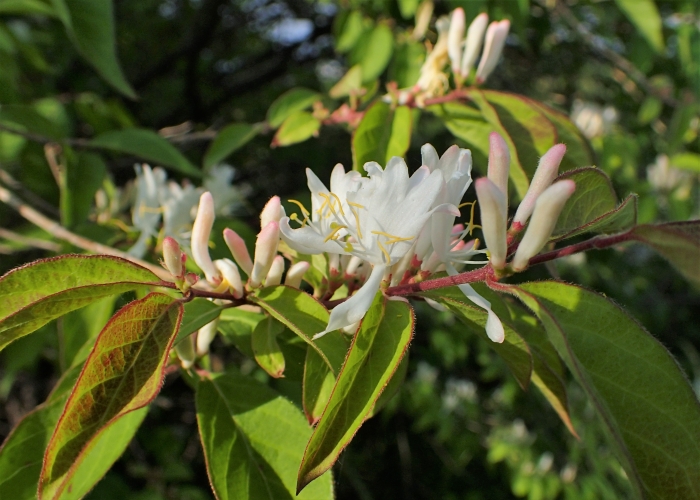Sweet Breath Of Spring
(Lonicera fragrantissima)
Sweet Breath Of Spring (Lonicera fragrantissima)
/
/

Krzysztof Ziarnek, Kenraiz
CC BY-SA 4.0
Image By:
Krzysztof Ziarnek, Kenraiz
Recorded By:
Copyright:
CC BY-SA 4.0
Copyright Notice:
Photo by: Krzysztof Ziarnek, Kenraiz | License Type: CC BY-SA 4.0 | License URL: https://creativecommons.org/licenses/by-sa/4.0 | Uploader: Kenraiz | Publisher: Wikimedia Commons | Title: Lonicera_fragrantissima_kz02.jpg | Notes: User created page with UploadWizard |
































































































Estimated Native Range
Summary
Lonicera fragrantissima, commonly known as Sweet Breath of Spring, is a semi-evergreen shrub native to forest margins and scrublands in East Asia, particularly China. It exhibits a variable habit, sometimes remaining evergreen in milder climates but can be deciduous where winters are harsher. This honeysuckle typically grows 1 to 3 meters (3.3 to 9.8 ft) tall and can reach up to 4.6 meters (15 ft) at maturity, forming a bushy mass of slender, spreading branches. Its flowers, which appear in late winter to early spring before the leaves, are creamy white, highly fragrant with a lemony scent, and about 1 centimeter (0.39 in) long. The red berries that follow are also notable, though not as showy as the flowers, and are dispersed by animals that consume them. The seeds require cold stratification to germinate.
Sweet Breath of Spring is valued for its early, fragrant blooms that signal the end of winter and is often used as an ornamental plant in gardens and as a hedge. It thrives in full sun to part shade and prefers soils with medium drainage, requiring low to medium amounts of water once established. While it is not particularly demanding, it can become invasive outside its native range, spreading through seed and suckering, and should be planted with caution. It is also susceptible to powdery mildew and honeysuckle aphids.CC BY-SA 4.0
Sweet Breath of Spring is valued for its early, fragrant blooms that signal the end of winter and is often used as an ornamental plant in gardens and as a hedge. It thrives in full sun to part shade and prefers soils with medium drainage, requiring low to medium amounts of water once established. While it is not particularly demanding, it can become invasive outside its native range, spreading through seed and suckering, and should be planted with caution. It is also susceptible to powdery mildew and honeysuckle aphids.CC BY-SA 4.0
Plant Description
- Plant Type: Shrub
- Height: 6-10 feet
- Width: 6-10 feet
- Growth Rate: Moderate
- Flower Color: Cream, White
- Flowering Season: Spring, Winter
- Leaf Retention: Semi-deciduous
Growth Requirements
- Sun: Full Sun, Part Shade
- Water: Low, Medium
- Drainage: Medium
Common Uses
Bee Garden, Bird Garden, Border Plant, Butterfly Garden, Deer Resistant, Drought Tolerant, Erosion Control, Fragrant, Hedges, Hummingbird Garden, Low Maintenance, Salt Tolerant, Showy Flowers
Natural Habitat
Forest margins and scrublands in East Asia, particularly China
Other Names
Common Names: Fragrant Honeysuckle, Winter Honeysuckle, Kiss-Me-At-The-Gate, Winter-Flowering Honeysuckle, Wohlriechende Heckenkirsche, Clématite D’Hiver
Scientific Names: , Lonicera fragrantissima, Lonicera caprifolioides, Abelia splendens, Chamaecerasus niagerilli, Lonicera fragrantissima var. fragrantissima,
GBIF Accepted Name: Lonicera fragrantissima Lindl. & Paxton